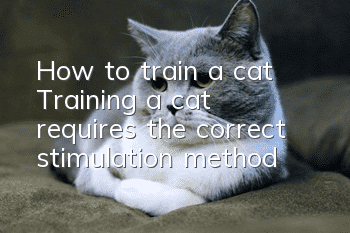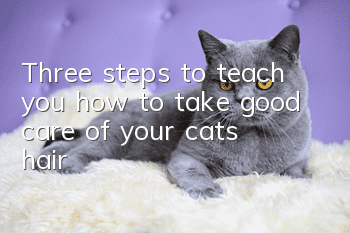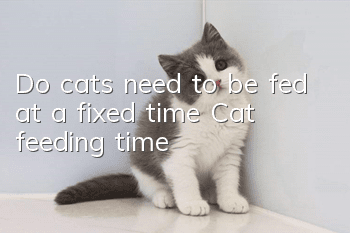How to train a cat? Training a cat requires the correct stimulation method!

Chinese Cihua Cat (detailed introduction)
How to train a cat? Training a cat requires the correct stimulation method! We know that compared to dogs, training cats is much more difficult. But this does not mean that cats are stupid. On the contrary, cats are very smart. It is just that their personalities make them less easy to be domesticated. Most cats are naturally aloof and difficult to get close to, even if they are arrogant towards their owners. Therefore, if you want to train a cat, you must use appropriate stimulation methods, which may achieve more significant results.
Cats are talented and intelligent, but most of them like to be alone and are very curious. They are very interested in bugs, threads, ropes, paper balls, and leaves blown by the wind. Usually, cats can instinctively make various interesting actions such as rolling, raising their limbs in the air, and standing upright when teased by their owners.
However, it is much more difficult to train cats to do some more complex movements than dogs. This is because cats are very independent and have an extremely stubborn character that does not want to be manipulated by others. Even if the owner doesn't let the cat do something it likes, it won't do anything if the owner doesn't like it. If the cat doesn't like something, it won't accept it even if it is forced to do it. In addition, cats are alert by nature and are easily afraid of bright lights and large crowds of people, so it is more difficult for them to perform in public.
But as long as you have patience and combine scientific methods, cats can still be tuned and trained in a short period of time. The completion of all cat behaviors is based on neural reflexes as its physiological basis. The so-called reflex activity is the process in which the body reacts through the activity of the nervous system after the body's receptors are stimulated by certain stimuli. For reflex activity to occur, there must be stimulation. Stimuli refer to those that can be sensed by the body's tissue cells and can cause certain reactions. Changing internal and external environmental factors. Such as tapping, pressing, light, sound, temperature, etc. Cats have various sensitive receptors in their bodies, such as vision, hearing, smell, and various temperature, pain, and touch receptors in the skin. They can each sense different stimuli and convert these stimuli into neural excitation processes. When the excitement reaches the brain along the afferent nerves, the brain responds immediately and transmits instructions to the effector through the efferent nerve, causing the effector to take corresponding actions.
Animal reflexes can be divided into two categories: unconditioned reflexes and conditioned reflexes. Unconditioned reflex is an innate reflex that animals are born with and is the most basic and important reflex activity for animals to maintain life. For example, kittens will be able to suck milk and breathe when they are born. Stimuli that can cause unconditioned reflexes are called unconditioned stimuli, such as food, touch, tapping, etc. Conditioned reflexes are neural reflex activities that are gradually formed after an animal is born and adapts to the living environment during its life. It is acquired. This reflex is an advanced neurological activity that ensures a high degree of balance between the animal's body and the surrounding environment. It is a habit formed during the feeding and management process and various abilities developed through training. It is an individual-specific reflex activity.
The cat’s unconditioned reflex is the basis of conditioned reflex. Any kind of conditioned reflex is based on unconditioned reflex.Apply effective stimulation methods to enable cats to develop the abilities that people need. Therefore, training cats uses the cat’s conditioned reflex. When training a cat, the cat does not understand the true meaning of the commands and gestures issued by the owner, but makes it a habit through training. That is, when the cat hears a certain command or sees a certain gesture, it will make corresponding actions.
Stimulation methods for cat training: unconditioned stimulation and conditioned stimulation.
Unconditioned stimuli: Unconditioned stimuli include mechanical stimuli and food stimuli. Mechanical stimulation refers to the mechanical effects exerted by the trainer on the cat's body, including patting, stroking, pressing, etc. Mechanical stimulation is a mandatory sub-segment, which can help cats make corresponding movements, fix postures, and correct mistakes. The disadvantage of mechanical stimulation is that it can easily cause mental stress in cats and inhibit training.
Food stimulation is a means of reward and has a good effect. However, the food used must be something the cat likes. Only when the cat becomes interested in food will good results be achieved. At the beginning of training, every time an action is completed, the cat will be rewarded with food, and then gradually reduced until finally no food is given. In actual training, combining the two stimulation methods will achieve better results.
Conditioned stimuli: Including passwords, gestures, whistles and bells, etc. Commonly used conditioned stimuli are verbal commands and gestures, especially verbal commands are the most commonly used stimulus. During training, the command must be combined with the corresponding unconditioned stimulus to enable the cat to form a conditioned reflex to the command. The tones of the various passwords should be different, and the tones of each password should be consistent. Gestures are a kind of stimulation that uses hands to make certain postures and shapes to command cats. Gestures play an important role in cat training. When creating and operating gestures, attention should be paid to the independence and legibility of various gestures. Each gesture should be stereotyped, used accurately, and clearly different from daily actions.
Whether it is a cat or a dog, training is done through stimulation. With constant stimulation, it becomes a habit, so even cats can still achieve better results as long as they are patient. The training effect is good, but the owner must master the correct stimulation method to avoid it being counterproductive.
- Cat's stomach is twitching and vomiting yellow water
- Cat keeps going to the toilet
- How long does it take for a kitten to start sucking milk?
- Cat vomits cat food but is in good spirits
- How to stop cats from spraying? Cat corrective training!
- What is feline vestibular syndrome? The causes and symptoms of feline vestibular syndrome!
- Why should cats be dewormed regularly? The importance of deworming cats!
- Why does my cat pee everywhere at home?
- Sweets are harmful to cats
- Breeds of pet cats How are cats classified?



